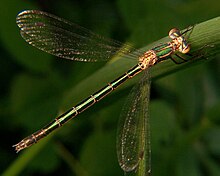Shiny rush maiden
| Shiny rush maiden | ||||||||||||
|---|---|---|---|---|---|---|---|---|---|---|---|---|

Shiny rush damsel ( Lestes dryas ), male |
||||||||||||
| Systematics | ||||||||||||
|
||||||||||||
| Scientific name | ||||||||||||
| Read dryas | ||||||||||||
| WF Kirby , 1890 |
The glossy rush damsel ( Lestes dryas ) is a dragonfly of the genus of the rush damsel ( Lestes ) and belongs to the family of the pond damsel (Lestidae).
description
The glossy rush virgin reaches a wingspan of about five centimeters. It has a metallic-green colored thorax and a glossy black-green abdomen , which in the sexually mature male is thickened at the end and frosted blue. With age, the dark areas of the body become coppery and duller. The wing marks are monochrome blackish.
The species can easily be confused with the much more common European rush damsel ( Lestes sponsa ). Certainly, both can only be distinguished by looking at the inner abdominal appendages in males or the laying spine in females with a magnifying glass. Also in the male the second abdominal ring (2nd segment behind the wing base) is not completely blue frosted. In direct comparison, Lestes dryas looks a bit stronger and shinier.
distribution and habitat
The glossy rush damsel is distributed Holarctic , it occurs accordingly in Europe, Asia and North America.
In stagnant waters with strongly fluctuating water levels and rush stands as well as in bog waters , the glossy rush virgin occurs in places quite numerous. She often performs with Lestes sponsa . The flight time ranges from June to September. In southern Europe, the species can train two generations in summer.
Way of life
The behavior of the glossy rush damsel is very similar to that of L. sponsa . Mostly they are found sitting on vertical parts of the plant, which is where mating takes place. The eggs are mated in vertical plants protruding from the water such as z. B. rushes stung. The animals climb down the stem until their bodies are usually completely immersed in the water. The oviposition rarely takes place without the male.
The larvae hatch from the overwintered eggs in April. After only a very short larval phase, the metamorphosis to the finished imago takes place in the same summer .
literature
- Gerhard Jurzitza: The Kosmos dragonfly guide . Franckh-Kosmos Verlags GmbH & Co., Stuttgart 2000, ISBN 3-440-08402-7


